
HEMP HISTORY ROOM
USA Hemp Museum Store - Bookmark This Site - Museum Link - Email The Museum
 |
HEMP HISTORY ROOM USA Hemp Museum Store - Bookmark This Site - Museum Link - Email The Museum |
|
HEMP SAILING SHIPS: Hemp Navigates
the Globe. |
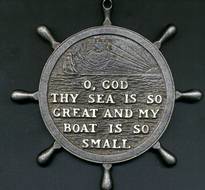 |
O, GOD |
| A. Early history
- 6,000 B.C. to 1000 A.D. B. Middle Ages - 1000 A.D. to 1500 A.D. C. Age of Sail - 1500 A.D. to 1800 A.D. D. End of An Era- 1800 A.D. to 1900 A.D. E. The Clipper Ships - 1840 A.D. to 1900 A.D. 11. A. Early history of sailing ships from 6000 B.C. to 1000 A.D. People could sail before they could write, so much of the earliest development of the sail is conjecture. With so much water on the planet (two thirds of the surface), people had to sail. And sail they did, across rivers, lakes, seas, oceans, and around the world. |
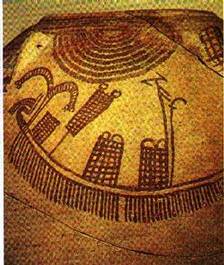 |
Egyptian river boat of 3300 B.C. on
pottery. One of the oldest records of a
sail. From The History of Ships. |
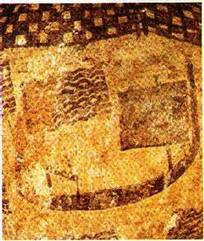 |
Earliest known picture of a vessel under sail, from an Egyptian pottery decoration of 3100 B.C. - From The History of Ships. |
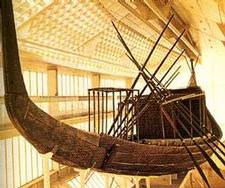 |
"The earliest ship - for she was a great deal bigger than a boat - about which we have real knowledge is the funeral ship of the Pharaoh Cheops, the builder of the great pyramid at Gizahttp://www.hempmuseum.us.It is generally accepted he lived about 2600 B.C." - From Kemp, The History of Ships. |
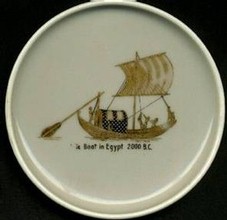 |
Museum ashtray showing a boat in Egypt -2000 B.C. |
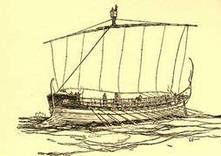 |
Greek Galley. From 600 B.C. |
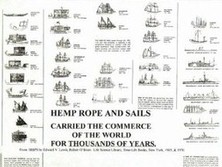 |
Hemp Museum display of the history of ships. |
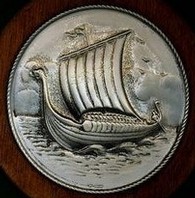 |
Hemp Museum plack, aluminum on wood, showing a Viking long boat under sail. |
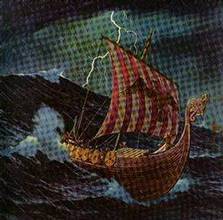 |
Viking Long Boat. |
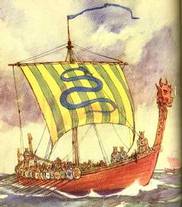 |
Viking Long Boat from about 1000 A.D. |
| 11. B. Middle Ages of Sailing, 1000 A.D. to 1500 A.D. Up to this time, from the earliest dugout to the Viking longboats, vessels were propelled by oars or a single square sail. During the Middle Ages, triangular lateen sails were introduced and later were incorporated in the two- or three-masted carrack. |
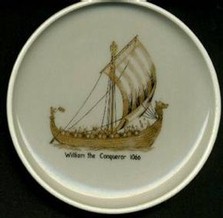 |
William the Conqueror - 1066.
Hemp Museum ashtray. |
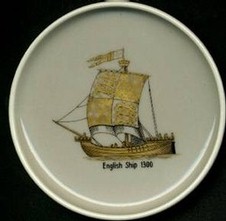 |
Ashtray showing an
English ship from 1300 A.D.
Hemp Museum ashtray. |
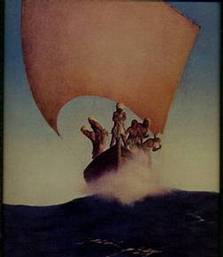 |
An Arab
sailing ship shows the power of the wind caught in a hemp sail.
Hemp Museum framed print, 9 X 11 inches. |
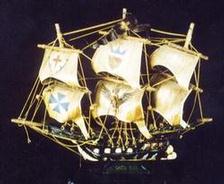 |
Model of ship the
Santa Maria that took Christopher Columbus on his voyage
of 1492.
Hemp Museum model. |
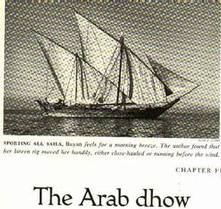 |
The Arab dhow. |
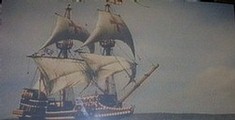 |
Ship of the History Channel.
An off-the-TV digital photo. |
| 11. C. The Age of Sail: This lasted through the 16th, 17th and 18th Centuries. In response to the competitive demands of warfare, trade and global exploration, large wooden-hulled, full-rigged warships and merchant vessels were built that could sail anywhere in the world." From Lewis & O'Brien, SHIPS, 1965. |
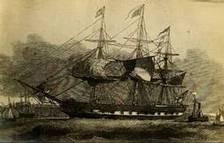 |
Man-o-war. Frigate.
Hemp Museum postcard. |
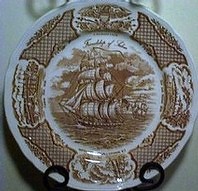 |
Friendship of Salem.
Hemp Museum plate. |
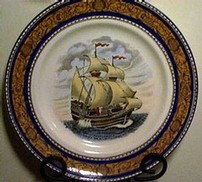 |
MAYFLOWER. The three-masted
merchant ship that brought the Pilgrims to the New World in 1620
was quite small by modern standards - 90-feet in length.
Thirty seamen were needed to handle the 180-ton vessel.
Her average speed was about 60 miles a day. A reproduction
of this ship, the Mayflower II, shown here and below, was built
in England. Hemp Museum plate. |
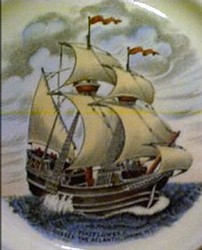 |
Detail of above plate showing
the Mayflower II. "No pains were fpared that this
might be a moft faithful Facfimile, built of the stouteft
hand-hewn Devon Oak, fitted with the finest hempen Cordage, with
Sails cut according to the Patterns of Centuries paft."
|
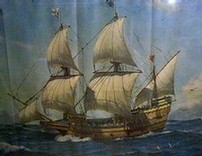 |
Mayflower II, from National Geographics, 1957. "In
the Year of Our Lord 1957, this gallant Veffel boldly croffed
the great Atlantic, even as did her namefake which bore the
Pilgrim Fathers. A gift by Virtue of the Generofity of the
People of Great Britain to her Majefty's former Subjects in
America. Framed Hemp Museum print. |
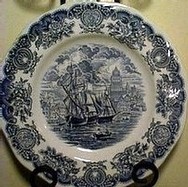 |
Port of Bristol.
Hemp Museum plate. |
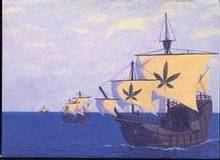 |
A reminder of what made the sailing ship go. |
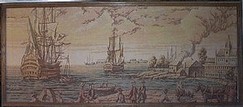 |
Hemp Museum Tapestry, 5 X 2 feet. |
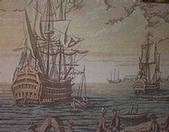 |
Tapestry detail. |
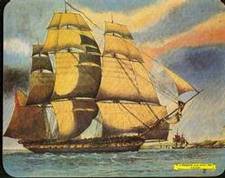 |
A FRIGATE, Under all sail,
1828. E. W. Cooke.
Hemp Museum place mats (5) 8 X 10 inches, showing English sailing vessels. |
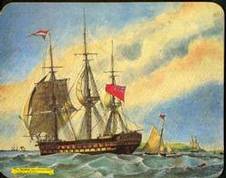 |
The THAMES (East Indiaman) 1828. E. W. Cooke. |
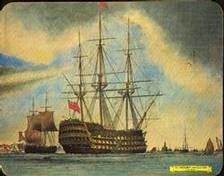 |
The VICTORY (104 Guns) 1828. E. W. Cooke. |
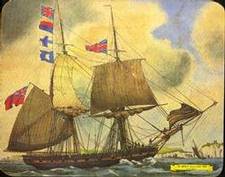 |
The WOLF (Brig of War) 1828. E. W. Cooke. |
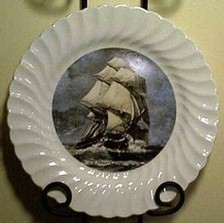 |
U.S. FRIGATE CONSTITUTION.
Hemp Museum dinner plate. |
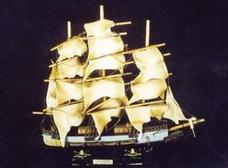 |
U.S.S. CONSTITUTION.
Hemp Museum model.
|
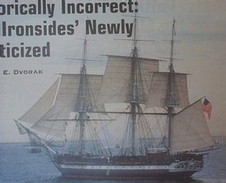 |
U.S.S. CONSTITUTION sails again! |
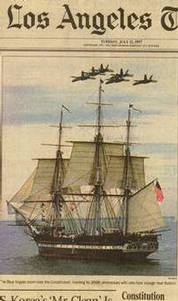 |
This ship was nicknamed "Old Ironsides", because cannonballs bounced off her two and one half foot thick oak hull. The Constitution's home port is the Boston Naval Yard, Boston, Massachusetts. |
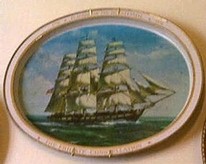 |
The Frigate Constellation was
the first commissioned ship of the new U.S. Navy, in 1797.
She is now a national historic shrine at her home port of
Baltimore.
Flagship of the Bicentennial, 1776 - 1976. Hemp Museum tin platter. |
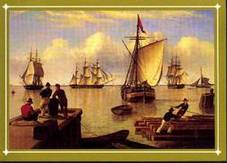 |
JUNO, By Isaac Heard. |
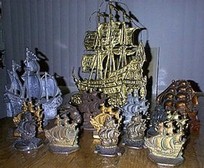 |
Sailing Ships as lamps, door stops, book ends are reminders of the importance of hemp in the history of sailing. Hemp Museum collection. |
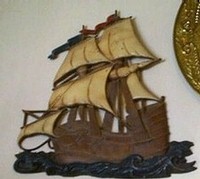 |
Sailing ship wall plack. 14
inches high.
Hemp Museum collection. |
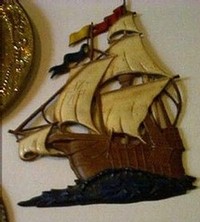 |
Sailing ship wall plack. 17
inches high.
Hemp Museum collection. |
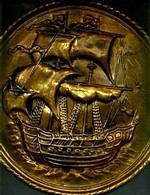 |
Here and below are several of the
tin placks picturing sailing ships. The age of sail
inspired many sailing ship images, on bottles, tins, boxes, book
ends, lamps, door stops, plates, and canvas.
Hemp Museum collection. |
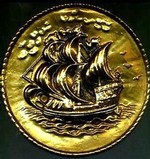 |
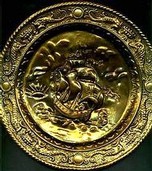 |
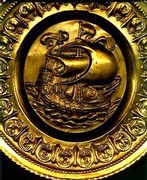 |
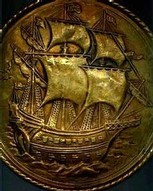 |
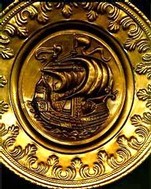 |
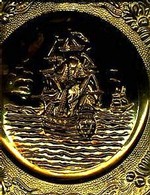 |
11. D. End of An Era - 1800 A.D. to 1900 A.D.
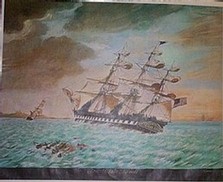 |
JAMES I. EVANS, "THE
WHITE SQUALL." Collection of Edgar William and Bernice
Chrysler Garbisch, NY.
"No information has come to light about this artist who signed his canvases alternatively Evans, J. I. Evans, or J. Evans. His boats are carefully painted down to the smallest detail; he was especially fine at painting rigging." |
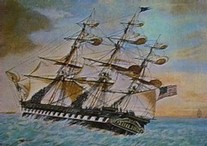 |
Painted between 1825 and l850,
Evans did not identify this three-masted schooner. A
White Squall is a type of weather where the wind is strong
enough to whip the waves into frothy white foam.
From a Hemp Museum print, 14 X 18 inches. Detail. |
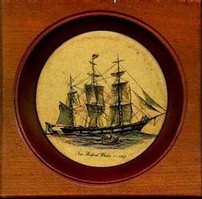 |
New Bedford Whaler - 1842.
Hemp Museum wall plack - 6 X 6 inches. |
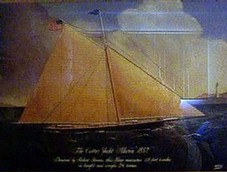 |
The Cutter Yacht 'Maria' -1857.
Designed by Robert Stevens, this Sloop measures 118 feet 6
inches in length and weighs 216 tonnes.
Framed Hemp Museum print by MRW. 15 X 19 inches. |
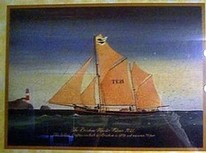 |
"The Brixham Trawler Fulmer
-TE21. This sailing drifter was built in Brixham in 1856
and measures 75 feet."
Also by MRW, this Hemp Museum print is 15 X 19 inches. |
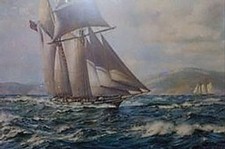 |
The Cutter California. California's State Historical Ship. |
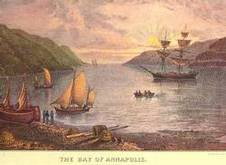 |
THE BAY OF ANNAPOLIS. Currier
& Ives.
|
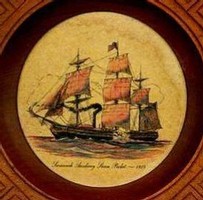 |
Savannah Auxiliary Steam
Packet - 1819.
Hemp Museum wall plack - 6 X 6 inches. |
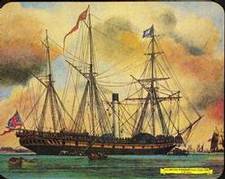 |
The UNITED KINGDOM Steam Vessel,
1829. E. W. Cooke. The early steam vessels had it
right. Why burn fuel when the wind is blowing?
Hemp Museum place mat 8 X 10 inches. |
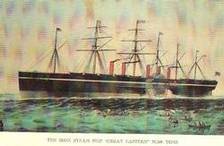 |
The Iron Steam Ship GREAT EASTERN - 22,500 Tons. |
11. E. The Clipper Ships
USA Hemp Museum Store - Bookmark This Site - Museum Link - Email The Museum